How we sold our first 100 domains without paying for ads

Starting a new business is never easy, and making your first sales can be the hardest part of the climb. Since we recently ticked past 100 domains sold on Chirpy Domains, it’s a good time for us to celebrate this early milestone, and to share a few tips for anyone else starting out.
It took about half a year for Chirpy Domains to go from zero to 100 domains registered, and we’re proud to say that we got there without paying for ads. Here’s a look at how we got ourselves started.
Why no ads?
We’re all about low prices. Literally the only thing we do is offer .au domains for $10.50 a year. The wholesale price for each domain, set by auDA, is $9.50. That leaves a dollar to cover all our other costs.
Semrush, a search marketing research tool, estimates if we ran search ads for the keyword “domain name”, each click would cost $7.79.
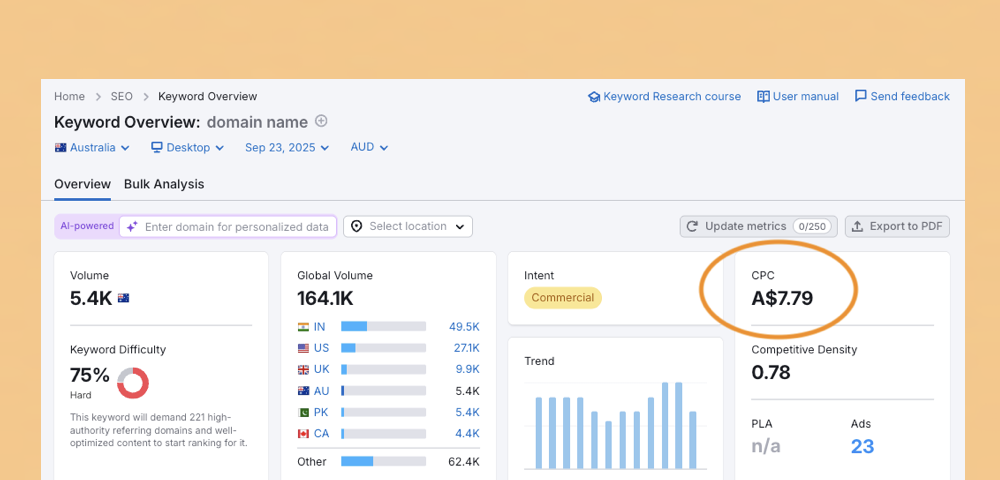
So the maths is clear: No ads for us!
The main engine: Organic SEO
Let’s start this section by saying that our site is by no means perfect, and there’s always more work to do. But in our few months online we’ve made enough progress to know that organic search can be our main source of traffic and growth.
Measuring progress: Search Console and Google Analytics
Before we went live with the Chirpy Domains website, we had a basic Google Analytics (GA4) property and Google Tag Manager installation working for us. We’ve also been tracking the site on Google’s Search Console.
With these simple, free tools in place from day 1 we’ve been able to see:
- What search terms people use when our site is presented as a search result.
- Through Search Console, our overall levels of search traffic.
- How site visitors reach us—although user behaviour, ad blockers and other limitations mean that GA4 will always give a hefty chunk of traffic a mix of unhelpful labels like “direct”, “other” and “not set”.
- Demographic details of our visitors. Most importantly, that our visitors are mostly from Australia.
- Bounce rates and engagement rates. Do people who arrive at our site actually stay and look around?
- The proportion who click through to the store and, ultimately, make a purchase.
None of this is rocket science, but it’s let us build a decent-enough view of a sales funnel. What paths have we built into Chirpy Domains? Are the right people finding those paths? Are drop-off rates a problem? Where are we losing people? All important questions which could point at different things to work on next.
One useful feature in Search Console is the ability to request indexing, rather than wait for Google’s bots to find you. New sites with no inbound links and very low volumes of traffic—pretty much just us making sure that everything looked okay—go to the back of the queue, so it still took a few days for us to appear.
Website performance: Speed matters
An important SEO signal, and one which doesn't depend on anyone apart from your own web developers and host, is a group of numbers known as your Core Web Vitals. These boil down to one thing: How fast does your site load? Quicker is better, and slower can incur penalties in your search ranking.
So from the very start we’ve had a close eye on these figures. As you can see, we’re doing well but there’s always room for improvement. The general signal that we’re giving Google is that we won’t keep our site visitors waiting, and that they’ll get a smooth experience here.
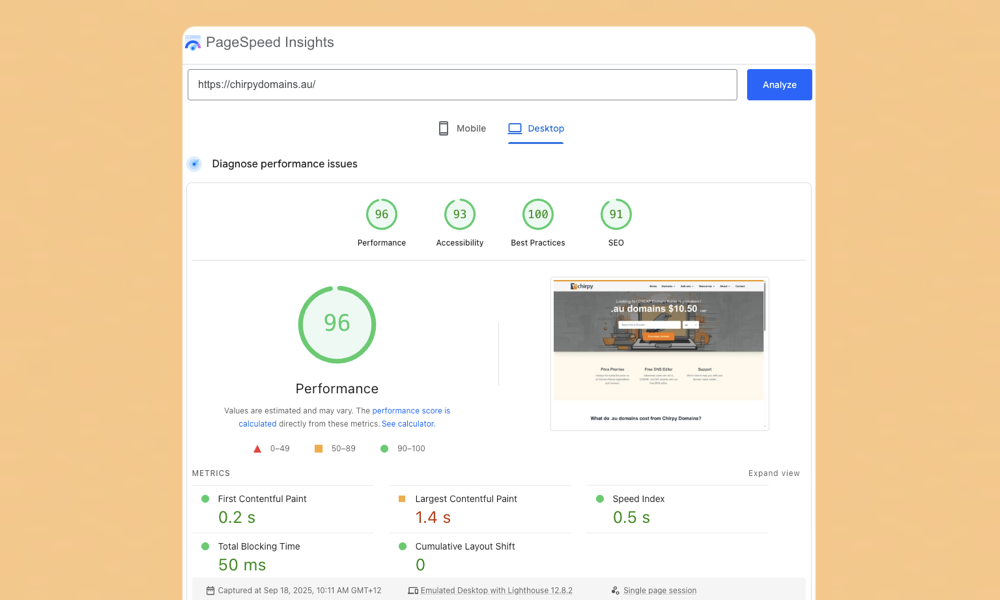
Read more about Core Web Vitals, load times and SEO from our sister company, MyHost: Improve your webpage load time to increase your SEO.
Data structure
As well as writing useful, unique content, it’s important to do what you can to spoonfeed that content to search bots/crawlers. You can do this without making any changes that are visible to humans with schema.org markups for things like blog articles and FAQs, for example. By wrapping our content in the right code we’re telling machines that this text is a question and that text is its answer. It makes our content easier for Google to digest and serve up in different ways (snippets, suggested questions, etc.).
Google Business Profile
After the site was live we created our Google Business Profile. Now when people search for us by name, a handy box all about us appears on the right hand side of search results. We’ve also added our single product, AU Domain Names, as a product within that profile.
This is another way to introduce ourselves to Google, and to improve the look and prominence of our search results.
Still waiting for that first customer review!
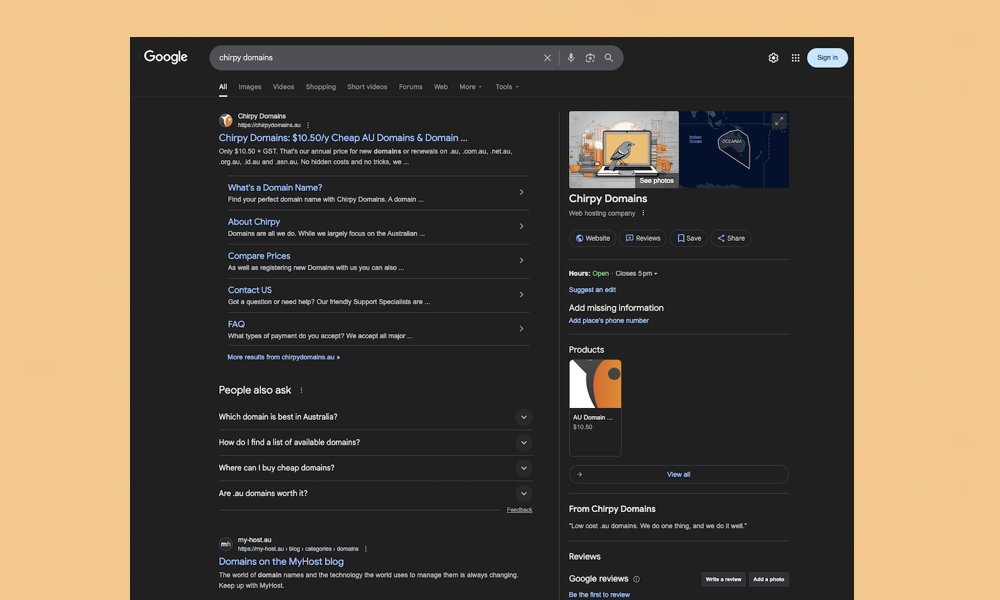
The numbers: How it started
Quietly. We got a small amount of traffic at first, probably from people who we talked to directly, and then the crickets came to visit.
We kept working by publishing articles, adjusting existing content, and looking for our first few backlinks. But, frankly, things were tough.
The unorthodox tweak that set us on our way
After a number of weeks with little traction and small amounts of lumpy traffic, it was a small change to our meta titles and home page H1 (first-level heading) that finally pushed the curve upwards. Since these changes, there’s been no looking back.
Obviously the searches that we are most interested in will come from people looking for AU domains at the lowest possible cost. So we expected searches for words like “cheap” and “low cost” to matter more than our actual price of $10.50. When we wrote our original site meta data and the main heading for our home page, we focused on cost but not on “$10.50” precisely.
Here is why experimentation is important: By adding “$10.50/yr” into both, we finally earned the kickstart that we’d been waiting for. In a move that actually goes against recommended SEO practices, we also applied the same page title site wide. It was an unorthodox gamble, but there’s no argument: This actually worked for us.
You can see from Google Analytics that when traffic started arriving, it kept coming:

Organic search was the main source of this traffic. Google Analytics says that that’s where about half our visitors come from. But a better way to visualise this is with the little awards that Google Search Console kept giving us:
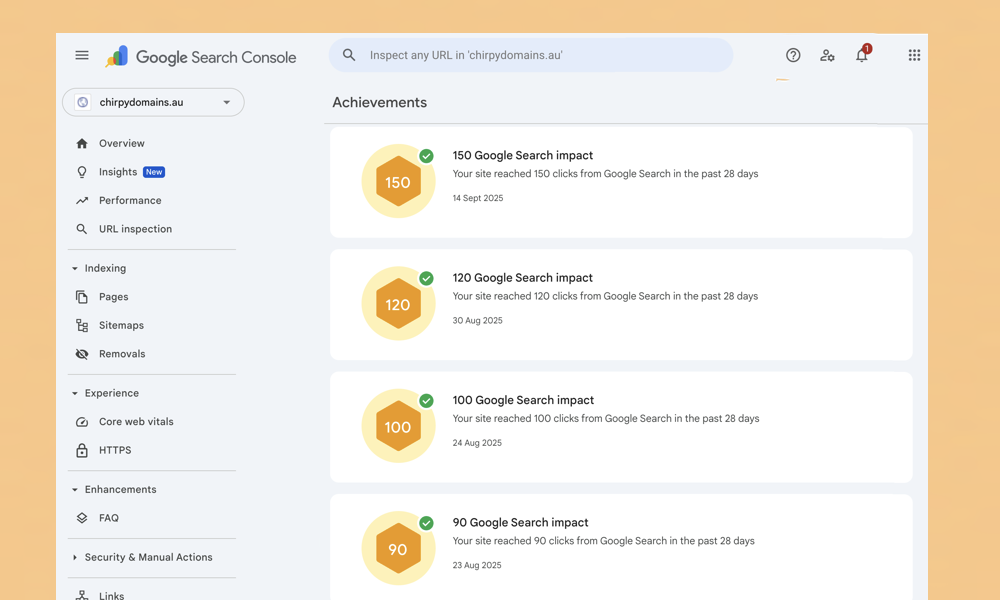
Even better, the funnel is working too. People who were arriving at the site were searching for domains, adding domains to their cart, and getting through the checkout process:
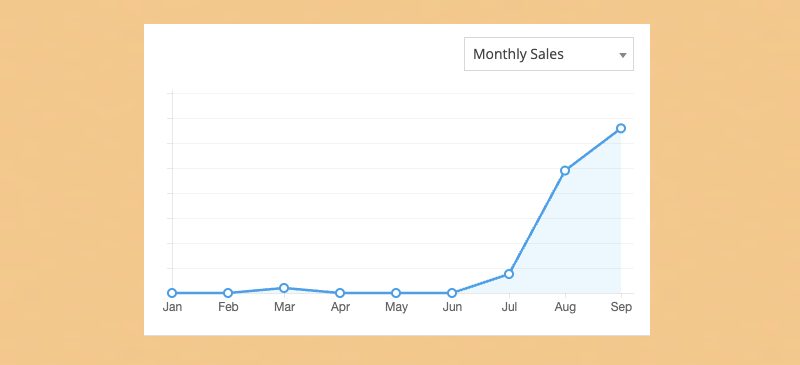
As well as showing that the business is making sales, this also loops good signals back to the SEO engine that we want to speed up. When site visitors engage with the site and interact with it, rather than bouncing out, Google notices and remembers.
In the graph above, domain #100 is somewhere in September’s total. The screenshot was taken when there was still a week left in the month, so it will angle up higher yet. The way things are going, #200 won’t be too far behind 🎉
You can imagine how good July felt, when we finally achieved liftoff. Momentum is a wonderful thing. What you really need to appreciate is that the work started back in February, and it continued through all those flat months in the middle.
The big lesson here: Once our work started paying off, it kept paying off. And there are more rewards to come.
The next boost: SEO’s new friend, GEO
GEO, or generative engine optimisation, is SEO for LLMs or AI chatbots like ChatGPT, Perplexity, Gemini and whatever else has been launched this week.
A lot of the principles are the same. Interesting, unique, well-structured content with clear answers to common questions will rank well. But the black box of AI chat and search is starting to be opened up and reveal some interesting differences, especially in how LLMs determine the trustworthiness of individual sites. This will definitely be an area of interest for us. In fact just recently we’ve added an llms.txt file to our site, which is our first move to communicate directly to the crawlers that feed large language models.
Is GEO actually important? Let’s find out by filter that Google Analytics graph to only show traffic from ChatGPT:

It lags the SEO upswing by around a week, and it’s growing more strongly towards the right-hand end. ChatGPT is quickly becoming more and more important. About 15% of our lifetime traffic came from that one chatbot. But in the last seven days it’s been over 20%.
Research into ecommerce has shown that visitors who come from AI recommendations are more likely to buy than regular Google searchers are, because they turn up with more information in hand and often with a decision already made. Interestingly, ChatGPT tends to send people straight to our webstore rather than the home page that Google prefers.
One note on this “AI vs Google” stuff is that the Google Analytics data that we’re looking at can’t tell the difference between clicks from regular search results and from Google’s AI Overview. Neither can Search Console. So there’s also AI-fuelled traffic hiding in amongst those “organic SEO” figures.
As GEO best practices are established, we’ll be doing our best to keep up and beat our competitors to implementing them.
What’s next?
However well things are going, and however sharp our price is, we can never assume that domains will keep selling themselves. So, here’s where we’ll be focusing next.
Sooner or later we will hit the limit of the “one page title for the whole site” gamble. We’ll switch to page-by-page titles soon, the way websites ought to be, and see whether the acceleration of non-home pages makes up for any weakening of our overall message. We’re optimistic, since the change will realign our site with best practices and surface deeper content like blog posts about auDA’s dispute policy and different types of DNS records.
There’s a human side to consider as well. As we build a customer base, how can we encourage people to log in and buy a second or third domain? No-one wants a flood in their inbox, so this needs careful consideration.
Now that we’re ever-so-slightly established in the market we might be able to earn a few more backlinks, reviews, and appearances on ratings websites. As a totally fresh brand this was a struggle, but comparator sites that want to give Australians the full picture won’t be able to ignore us forever. If you have an OzBargain login and feel like adding us to their wiki page about cheap domains…
LLMs will be a bigger focus, too. Will the new llms.txt file make much of a difference? How else can we elevate our standing in the electronic minds of ChatGPT and its peers? There’s research to keep up with and experiments to run.
The Google search results that we need to topple
Today here’s what’s on Google’s first page of results for an incognito search, ‘cheap au domain names’:
- Three ads, which we can’t compete with.
- An AI overview that mentions three retailers, but not us, and talks about “prices sometimes starting at around $14.95 for the first year”. It would be great if our $10.50 got a mention there.
- Links to five domain retailers with higher regular prices than us (from $14 to $23.95).
- A sixth retailer that’s no longer trading after a merger.
- An listicle about AU domain retailers which was slapped together so quickly that it wrongly recommends auDA, the regulator, as a seller of domains.
- OzBargain’s “Cheap .AU Domain Names” page, which is a useful but incomplete source. It’s a wiki, so we tried to add ourselves when we launched but were quickly removed, perhaps because we were new at the time?
- TLD-list, which focuses on large international retailers. Maybe we’ll be there one day.
- Three more ads.
It’s a mountain to climb, but from our results so far we know that we can belong there. It’s just a matter of working hard every day, so more and more people search for a cheap domain with us, rather than our competitors.